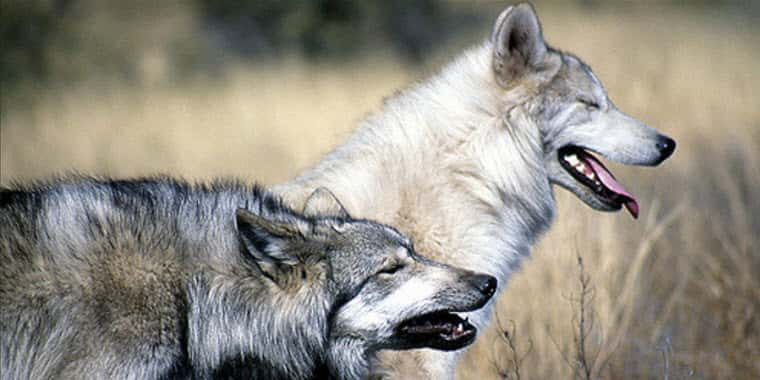The Montana Fish and Wildlife Commission finalized wolf hunting and trapping regulations during a lengthy meeting last week where commissioners heard passionate comments from people around the country. The commission received over 1,100 pages of public comments regarding the species’ management.
Sharing Agriculture’s Concerns
“What is of utmost importance is that state management of wolves be maintained,” said MFBF State Governmental Affairs Coordinator Karli Johnson who shared the organization’s views during the commission meeting. “We appreciate the good work of the department and commission to continue to manage wolves in a sustainable way while taking into consideration the detrimental effect wolves have on ranchers and being willing to continue to work to keep the population in check.”
Since Farm Bureau members lose livestock to wolf predation, management is a strong concern. MFBF outlined the many ways that wolf predation has long-term economic consequences on livestock and ranches. A recent article from the American Farm Bureau Federation outlined those, including the direct loss of animals, stress-related impacts on livestock health, and the costs associated with mitigation efforts. It estimates that wolves in Montana cost ranchers nearly $23 million through increased stress on cattle, and additional management expenses.
“It is important to note that these costs occur even when there is not direct predation; just the threat of predation can cause increased costs as ranchers take precautionary measures to co-exist or cattle deal with stress related to the presence of wolves,” noted MFBF Executive Vice President Scott Kulbeck. He added that livestock owners have made considerable efforts to coexist with wolves, but that has come at a substantial cost.
“These impacts underscore the importance of maintaining a balanced wolf population, one that considers both ecological sustainability, continued state management and the economic realities faced by Montana’s ranching community, which represents the largest segment of the state’s largest industry—agriculture,” Kulbeck pointed out.
Montana Farm Bureau supports the use of regulated hunting and trapping as responsible tools for managing the wolf population. They believe that increasing hunting and trapping quotas offer a win-win solution for Montana’s landscape and helps keep working lands in working hands and provides opportunities for hunters and trappers to engage with an iconic species.
Fish and Wildlife Commission Actions
The Commission debated several amendments to the 2025/2026 Furbearer and Wolf Hunting and Trapping Regulations proposal that FWP released in early July. Though the regulations cover all furbearer trapping and wolf hunting and trapping, the central focus of the discussion was crafting a new set of wolf regulations.
For the 2025/2026 wolf hunting and trapping season the Commission approved a 452 statewide wolf quota, which includes a sub-quota of 60 wolves in Region 3, and separate quotas of three wolves each in Wolf Management Units 313 and 316.
The Commission established that a person may harvest 15 wolves via trapping and 15 wolves via hunting, provided that five wolves from each method of take are harvested in FWP Region 1 or Region 2. Hunters must purchase a wolf license for each wolf they harvest via hunting, but they may purchase up to 15 licenses before going afield.
The Commission approved a regulation allowing a trapper to gain prior authorization from FWP to temporarily leave the live wolf in the trap for the purpose of radio collaring by FWP. In this circumstance the wolf would not be harvested, but the trapper would immediately notify FWP, per the prior authorization arrangement, and a FWP official would radio collar the wolf and release it from the trap.
The Commission approved regulation changes to require that all harvested wolves must be presented to FWP for inspection within 10 days of harvest for pelt tagging, tissue sampling, and tooth extraction. A trapper must present the hide and skull for tagging and sampling within 10 days of harvest. It is now illegal to leave a wolf hide and skull in the field after harvest, even if the hunter or trapper doesn’t want to keep the animal.
The Commission removed trapping setbacks on roads closed to motor vehicle and OHV traffic (except snowmobiles and unless in a designated no trapping area) in Mineral County and on the Spotted Bear Ranger District in northwest Montana.
FWP staff will finalize the regulations and release them online in the coming days. Printed regulations will be available later this summer.
Archery wolf season opens Sept. 6. Trapping season will open Dec. 1, except within the geographic area identified by federal court order. Just like last season, trapping within the geographic area will be limited to Jan. 1 to Feb. 15. The geographic area is all of FWP regions 1, 2 and 3, and portions of regions 4 and 5. This area, with limited trapping dates, is the same as last year, according to the FWP proposal. Outside this geographic area, wolf trapping closes March 15, 2026, or when a quota is met.
###
FWP/MFBF


